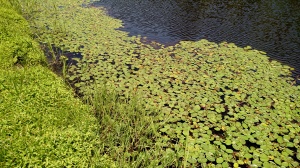
Aquatic dye is an effective way to reduce the growth of algae and submerged weeds in ponds, according to Scott Jones, small impoundment Extension specialist, Department of Aquaculture/Fisheries at the University of Arkansas Pine Bluff. Dyes block important wavelengths of light from reaching plants that would use it for photosynthesis and growth.
“While dyes are effective tools for aquatic weed control in specific situations, they are not really herbicides. It would be akin to referring to a tarp as an herbicide because it killed grass shaded beneath it,” Jones said. “In fact, most dye brands are careful not to claim their products affect aquatic plants as to not draw attention from the Environmental Protection Agency who regulates such things.”
The primary ingredient in most aquatic dye is Acid Blue 9, he said. Some dyes contain an additional pigment, Acid Yellow 23. The additional pigment blocks a wider range of wavelengths of light making them more effective aquatic weed controls.
“Dyes are most effective at prevention of fully submerged weeds like hydrilla, coontail, sago pondweed, chara, filamentous algae and the like,” Jones said. “Dye has little to no effect on fully mature weeds that have reached the surface, and emergent weeds like cattails, alligator weed and water primrose.”
For the best effect, dyes should be applied before the growing season begins (in winter or early spring before waters reach 55°F) and the label-recommended concentration maintained with periodic booster doses throughout the year (weeks to a few months between boosters depending on seepage and rainfall), he said. This will suppress seedlings from surviving when they emerge, preventing the weed problem before it materializes.
“If an infestation is already fully established, dyes can be used as a follow-up to herbicides to suppress regrowth for longer-term control,” Jones said. “Dyes are not able to control weeds growing in less than about 3 feet of water so use on shallow ponds may be entirely ineffective.”
Dyes are a cost-effective weed management tool especially for small to intermediate sized ponds with average depths over about 4 feet, he said. An integrated approach using physical removal, herbicides, dyes and biological controls (usually grass carp) tends to provide better results than either one approach on its own.
“Another consideration is that the non-selective nature of dye suppresses beneficial green algae too. Green algae are the base of aquatic food chains and the source of most dissolved oxygen in ponds and lakes,” Jones said. “While dyes do not pose a risk of eliminating all algae as some true herbicides can, pond owners should be aware that growth and total biomass production of fish can be somewhat reduced by the consistent application of dye.”
For more information about algae and weed control in ponds, call Jones at (870) 575-8185 or email him at pondmanagement@uapb.edu.
The University of Arkansas at Pine Bluff offers all its Extension and Research programs and services without regard to race, color, sex, gender identity, sexual orientation, national origin, religion, age, disability, marital or veteran status, genetic information, or any other legally protected status, and is an Affirmative Action/Equal Opportunity Employer.



🌊💧 Aquatic dye, as explained by Scott Jones from UAPB, is an effective method to control algae and submerged weed growth in ponds. It works by blocking sunlight needed for photosynthesis, similar to how a tarp prevents grass growth by shading it. The main ingredient, Acid Blue 9, and sometimes Acid Yellow 23, are used to block a range of light wavelengths. While dyes are not herbicides, they are most effective on fully submerged weeds like hydrilla and contail, and less so on mature or emergent weeds. For optimal results, dyes should be applied before the growing season starts and maintained throughout the year. They’re cost-effective, especially for deeper ponds, and can be part of an integrated weed management strategy. However, they may also suppress beneficial algae, slightly affecting fish biomass production. 🌿🐟 #PondManagement #AquaticDye